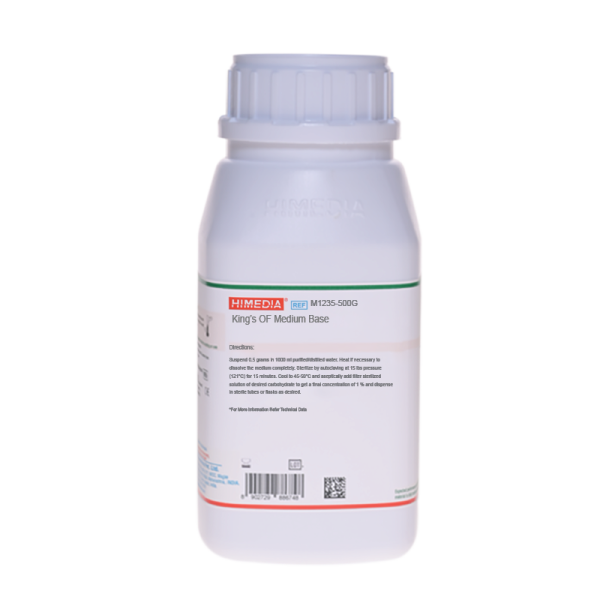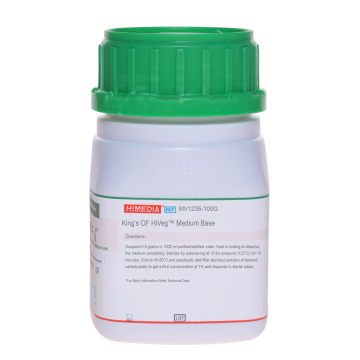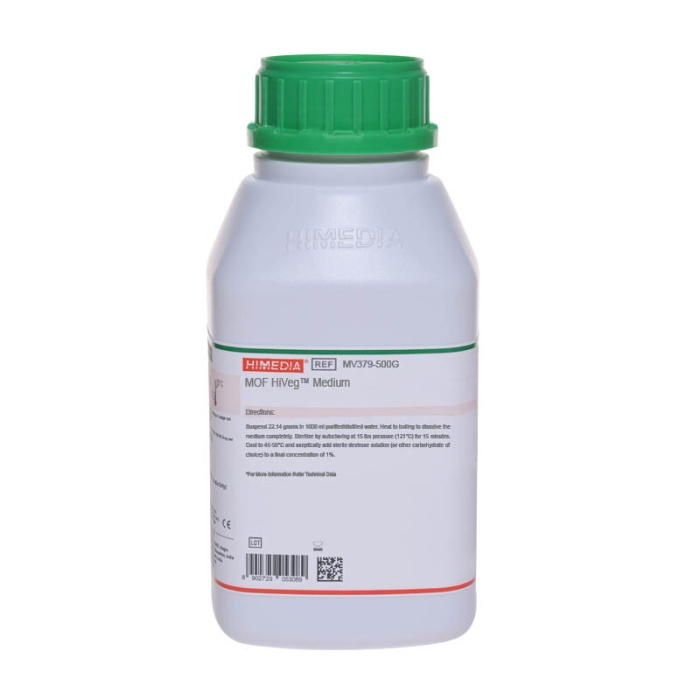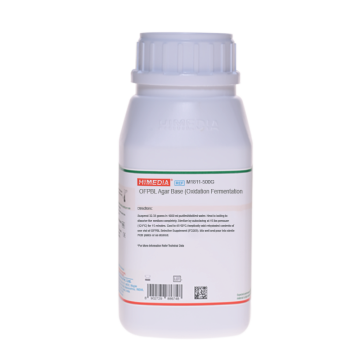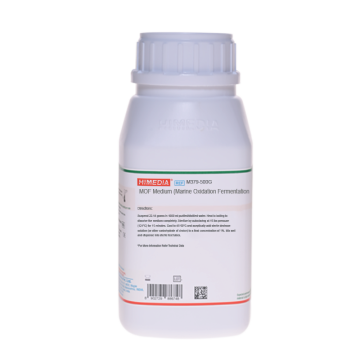 Your enquiry has been submitted
Your enquiry has been submitted
King’s OF Medium Base
Basal media#CC293D
Intended Use
Recommended for studying oxidation-fermentation of carbohydrates by Campylobacter species.
Composition**
| Ingredients | g/L |
|---|---|
| Tryptone | 0.200 |
| Phenol red | 0.003 |
| Agar | 0.300 |
| Final pH (at 25°C) | 7.4±0.2 |
**Formula adjusted, standardized to suit performance parameters
Directions
Suspend 0.5 grams in 1000 ml purified/distilled water. Heat if necessary to dissolve the medium completely. Sterilize by autoclaving at 15 lbs pressure (121°C) for 15 minutes. Cool to 45-50°C and aseptically add filter sterilized solution of desired carbohydrate to get a final concentration of 1% and dispense in sterile tubes or flasks as desired.
Principle And Interpretation
Campylobacter is a motile gram-negative bacterium that causes Campylobacteriosis when it gets lodged in the walls of intestine. They are usually carried in the intestinal tract of animals and therefore contaminate foods of animal origin. Although raw milk is a frequently reported vehicle of outbreaks of Campylobacter enteritis, studies have revealed that mishandled poultry is more important than raw milk in transmitting Campylobacter jejuni enteritis (1,2,3). The utilization pattern for several carbohydrates (e.g. lactose, maltose, xylose, sucrose etc) is often needed to help identify an organism genus and species. Kings OF Medium is formulated as recommended by APHA for studying the oxidation-fermentation reaction of carbohydrates by Campylobacter species (4).
Kings OF Medium contains tryptone, which supplies nitrogenous compounds required for the growth of Campylobacter species. Phenol red is the pH indicator. Oxidation of carbohydrate is indicated by a yellow colour formation. The medium will be yellow (acid) when removed from the microaerobic atmosphere due to CO2 absorption. To read OF reactions, let the tubes stand at room temperature until the OF control becomes neutral or alkaline, usually within 2 hours.
Type of specimen
Isolated Microorganism from clinical samples and food samples
Specimen Collection and Handling:
- For food samples, follow appropriate techniques for sample collection and processing as per guidelines (4).
- For clinical samples follow appropriate techniques for handling specimens as per established guidelines (5,6).
- After use, contaminated materials must be sterilized by autoclaving before discarding.
Warning and Precautions :
In Vitro diagnostic use. For professional use only. Read the label before opening the container. Wear protective gloves/ protective clothing/eye protection/face protection. Follow good microbiological lab practices while handling specimens and culture. Standard precautions as per established guidelines should be followed while handling clinical specimens. Safety guidelines may be referred in individual safety data sheets.
Limitations :
- Well isolated colonies must be used.
Performance and Evaluation
Performance of the medium is expected when used as per the direction on the label within the expiry period when stored at recommended temperature.
Quality Control
Appearance Light yellow to beige homogeneous free flowing powder
Gelling Semisolid, comparable with 0.03% Agar gel.
Colour and Clarity of prepared medium Light pink coloured, clear to slightly opalescent gel forms in tubes as butts
Reaction Reaction of 0.05% w/v aqueous solution at 25°C. pH: 7.4±0.2
pH 7.20-7.60
Cultural Response Cultural characteristics observed with added Dextrose under reduced oxygen atmosphere, after an incubation at 42°C for 24-48 hours.
| Organism | Growth | Acid (with dextrose) |
|---|---|---|
| Campylobacter jejuni subsp. jejuni ATCC 29428 (00156*) | good | positive reaction, yellow colour |
Key: *Corresponding WDCM numbers
Storage and Shelf Life
Store between 10-30°C in a tightly closed container and the prepared medium at 15-30°C. Use before expiry date on the label. On opening, product should be properly stored dry, after tightly capping the bottle in order to prevent lump formation due to the hygroscopic nature of the product. Improper storage of the product may lead to lump formation. Store in dry ventilated area protected from extremes of temperature and sources of ignition. Seal the container tightly after use. Product performance is best if used within stated expiry period.
Disposal
User must ensure safe disposal by autoclaving and/or incineration of used or unusable preparations of this product. Follow established laboratory procedures in disposing of infectious materials and material that comes into contact with clinical sample must be decontaminated and disposed of in accordance with current laboratory techniques (5,6).
Reference
- Deming M. S., Jauxe R. V., Blake P. A., Dixas S. E., Fowler B. S., Jones T. S., Lockamy E. A., Patten C. A. and Sikes R. O., 1987, Am. J. Epidemiol., 126: 526
- Gill C. O., and Harris L. M., 1982, Appl. Environ. Microbiol., 44:259
- Harris N.V., Weiss N. S., and Nolan C. M., 1986, Am. J. Publ. Health, 76:40
- Salfinger Y., and Tortorello M.L., 2015, Compendium of Methods for the Microbiological Examination of Foods, 5th Ed., American Public Health Association, Washington, D.C.
- Isenberg, H.D. Clinical Microbiology Procedures Handbook 2nd Edition.
- Jorgensen, J.H., Pfaller, M.A., Carroll, K.C., Funke, G., Landry, M.L., Richter, S.S and Warnock., D.W. (2015) Manual of Clinical Microbiology, 11th Edition. Vol. 1.
| Product Name | King’s OF Medium Base |
|---|---|
| SKU | M1235 |
| Product Type | Regular |
| Physical Form | Powder |
| Origin | Animal |
| Packaging type | HDPE |
| References | 1.Deming M. S., Jauxe R. V., Blake P. A., Dixas S. E., Fowler B. S., Jones T. S., Lockamy E. A., Patten C. A. and Sikes R.O., 1987, Am. J. Epidemiol., 126: 5262.Gill C. O., and Harris L. M., 1982, Appl. Environ. Microbiol., 44:2593.Harris N.V., Weiss N. S., and Nolan C. M., 1986, Am. J. Publ. Health, 76:4064.Vanderzant C. and Splittstoesser D. F., (Eds.), 1992, Compendium of Methods for the Microbiological Examination of Foods, 3rd Ed., APHA, Washington, D.C. |
| Customized Product Available | No |



